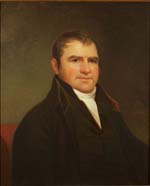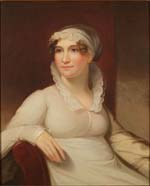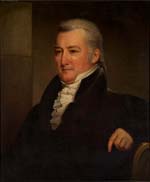Art & Artifacts
Discover the Library Company's Art and Artifact Collection
Distinguished Painters
Jacob Eichholtz
Born in Lancaster, Pennsylvania to German tavern keepers, Jacob Eichholtz (1776-1842) began his career as a coppersmith. Though he long harbored artistic aspirations, Eichholtz did not begin painting professionally until painter Thomas Sully visited him in 1809. Because he was married and needed to support his four children, he continued to work as a coppersmith but devoted much of his time to painting. However, in 1812, he traveled to Boston to briefly study under esteemed painter Gilbert Stuart, who observed his portrait of Nicholas Biddle and offered guidance. When his studio in Lancaster became too small, Eichholtz and his family relocated to Philadelphia in 1822, where he lived and painted for ten years. While in Philadelphia, he became proficient in drawing, figuring painting, and portraiture, and was commissioned to paint many men and women of standing. By 1833, he moved back to Lancaster and continued painting until his death in 1842. Though his artistic talents developed later in life, it was Eichholtz’s passion for painting that propelled his career forward, writing that it was “a fire that will never quench.”
Jacob Eichholtz (1776-1842).
John Markoe, ca. 1815.
Oil on canvas.
Library Company of Philadelphia. Gift of Mary De Witt Pettit, 1965.
Jacob Eichholtz, Portrait of John Markoe
John Markoe (1781-1834) was the son of Abraham Markoe, a successful sugar cane plantation owner from the Danish West Indies. Abraham immigrated to Philadelphia to pursue lucrative business interests, later passed on to John. The family was among the wealthiest and most lavish in Philadelphia; indeed, John was once described as "one of the most elegant, high-spirited, humorous, and attractive men that had ever delighted society." In 1810, Markoe hired Benjamin Latrobe, a family friend, to design an elegant Chestnut Street mansion. It was around this time that Markoe commissioned Jacob Eichholtz to paint the portrait of himself and his wife.
Jacob Eichholtz (1776-1842).
Mehitabel Cox Markoe, ca. 1815.
Oil on canvas.
Library Company of Philadelphia. Gift of Mary De Witt Pettit, 1965.
Jacob Eichholtz, Portrait of Mehitabel Markoe
Mehitabel Cox Markoe (1785-1863), known as Hitty, was the daughter of James S. Cox, a Bermudan native who would later become a renowned Philadelphian. She married John Markoe in 1804 and gave birth to eleven children. Recognized, with her husband, as one of the leaders of Philadelphia society, she is captured here in quiet elegance. Wearing an Empire dress and a lace headband, she sits serenely in this Eichholtz portrait.
Jacob Eichholtz (1776-1842).
Benjamin R. Morgan, 1823.
Oil on canvas.
Library Company of Philadelphia. Gift of Mrs. Robert W. Leaming, 1889.
Jacob Eichholtz, Portrait of Benjamin Morgan
Benjamin R. Morgan (1764-1840) was born in Gloucester County, New Jersey, but moved to Philadelphia early in his life and became active in philanthropic and political endeavors. After being admitted to the bar in 1785, he eventually became a judge on the District Court in 1821. He served as secretary of the Library Company from 1792 to1825 and as a director, 1825-1840. He was one of the founders of the Pennsylvania Academy of the Fine Arts in 1805, and also served as a trustee at the University of Pennsylvania from 1797 until his death in 1840.


